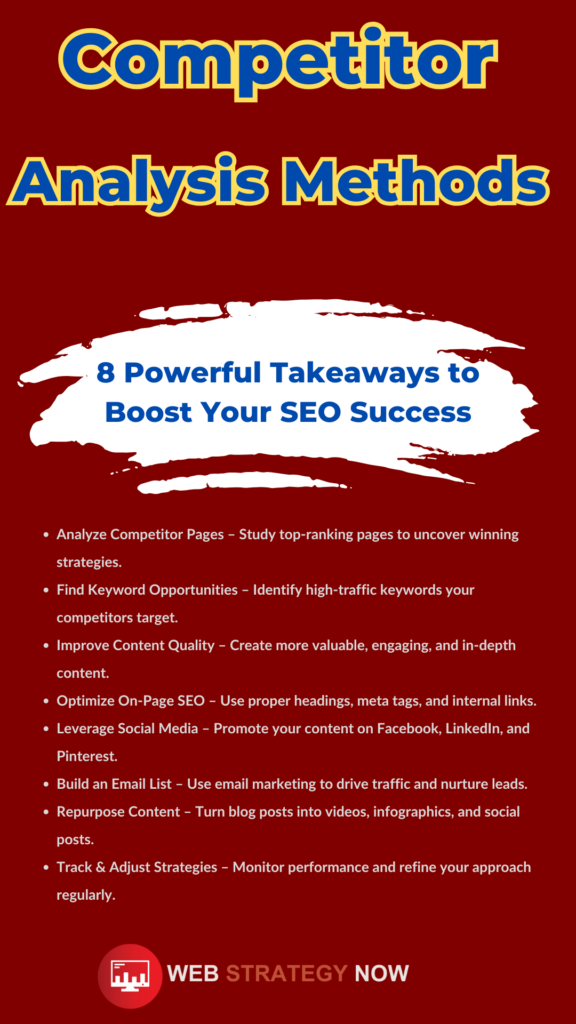Affiliate Disclaimer: This post contains affiliate links. If you purchase through them, I may earn a commission at no extra cost.
Mastering Competitor Analysis Methods
Want to dominate search rankings, drive more traffic, and increase conversions? Understanding what’s already working in your niche is the key. That’s where competitor analysis methods come in. Instead of guessing what works, you can reverse-engineer your competitors’ top-ranking pages, uncover their winning strategies, and create even better content.
By analyzing competitor pages, you can identify which keywords they target, how they structure their content, and what engagement strategies they use. This allows you to optimize your approach, improve your content quality, and outperform them in search results.
In this guide, you’ll learn the step-by-step process of conducting an in-depth competitor analysis, refining your SEO strategy, and positioning your website for long-term success. Let’s dive in.
Want to rank higher, get more traffic, and increase conversions? Then, you need to know what’s working in your niche. That’s where competitor analysis methods come in. By breaking down your competitors’ top-ranking pages, you can learn what’s driving their success—and do it even better.
Here’s how to do it.
Competitor research is the foundation of a successful SEO strategy. If you’re not analyzing what’s working for others in your niche, you’re missing out on valuable insights that could fast-track your growth. Top-ranking pages reveal patterns that search engines reward—patterns you can study, improve upon, and leverage to boost your own rankings.
By researching competitor pages, you gain access to:
- Industry trends – See what topics, formats, and strategies resonate with your audience.
- Content gaps – Identify areas your competitors are covering in-depth and where they fall short, giving you an opportunity to create even better content.
- User behavior – Understand what keeps visitors engaged and what elements drive them to take action.
- SEO tactics – Examine how competitors structure their pages, use keywords, and build authority through backlinks.
The goal isn’t to copy—it’s to innovate. Studying competitor pages helps you refine your content strategy, deliver more value, and stay ahead in the search rankings. Once you understand their strengths and weaknesses, you can build a content plan to outrank them.
If your competitors outrank you, they’re doing something right. Instead of guessing, study their content to find out:
- Competitor analysis methods – What strategies they use to rank.
- Keyword targeting – The terms bringing them traffic.
- User intent – What searchers want from their content.
- Content structure – How they present and format information.
- Backlinks – Where they get authority links.
- Engagement strategies – What keeps users on their page.
Once you understand their strengths and weaknesses, you can build a content plan to outrank them.
Step 1: Identify Your Top Competitors
Start by listing both direct and indirect competitors. Direct competitors sell the same products or services. Indirect competitors may not, but they target the same audience.
How to Find Your Competitors
- Google Search – Type in your primary keywords and check the top results.
- SEO Tools – Use Mangools or Neil Patel’s Ubersuggest to see who ranks for your keywords.
- Social Media – See which brands your audience follows and interacts with.
After compiling a competitor list, move to the next step.
Step 2: Analyze Their Keywords & Rankings
Keywords drive organic traffic. Understanding your competitors’ keyword strategies helps you find gaps and opportunities.
How to Analyze Competitor Keywords
- Find ranking keywords – Use an SEO tool to extract their top-performing terms.
- Spot content gaps – Look for high-traffic keywords they rank for that you don’t.
- Check keyword difficulty – Target keywords that are easier to rank for.
- Use long-tail keywords – These often convert better and face less competition.
This is one of the competitive analysis best practices—find what works and improve on it.
Step 3: Analyze Competitor Content Strategy
Your competitors’ top pages hold clues to their success. To outperform them, study their approach.
What to Evaluate:
- Competitor analysis methods – How they structure and optimize content.
- Content type – Blog post, product page, landing page?
- Length – Short-form vs. in-depth guides.
- Readability – Headings, subheadings, bullet points?
- Visuals – Do they use images, videos, or infographics?
- Call to Action (CTA) – How do they drive conversions?
- Engagement – Comments, shares, and user interactions.
With these insights, you can create better, more engaging content than your competitors.
Step 4: Optimize Your Content to Rank Higher
Now, apply what you’ve learned. Here’s how:
- Create Better Content
- Expand on what your competitors cover.
- Add expert insights, case studies, or original data.
- Use visuals to improve engagement.
- Improve Your Keyword Strategy
- Target high-value, low-competition keywords.
- Use competitor analysis metrics like keyword difficulty and search volume.
- Enhance On-Page SEO
- Optimize title tags, meta descriptions, and headers.
- Ensure mobile-friendliness and fast page speed.
- Use internal links to related content (Check out this guide for technical SEO tips.)
- Refine Your CTA
- Make your call to action clear and persuasive.
- Offer incentives like free guides or exclusive discounts.
- Consider using AWeber to build an email list.
Step 5: Track Your Performance & Adjust
Competitive analysis isn’t a one-time task. Keep tracking your progress with these competitive analysis metrics:
- Traffic growth – Are more users visiting your site?
- Ranking improvements – Are you climbing in search results?
- User engagement – Are visitors staying on your pages longer?
- Backlinks – Are other sites linking to your content?
Tools like Mangools help you monitor these metrics and tweak your strategy.

Step 6: Competitor Analysis Methods – Promote Your Content for Maximum Reach
Even the best content won’t rank if no one sees it. Once you’ve created high-quality content using competitor analysis methods, the next step is getting it in front of your audience. Promotion is just as important as creation, and the right strategies can maximize your reach, engagement, and conversions.
1. Leverage Social Media to Drive Traffic
Social media platforms are powerful tools for content distribution. A strong presence on Facebook, LinkedIn, Pinterest, and Twitter can bring in organic traffic and engagement.
- Share your content across different platforms at optimal times.
- Repurpose blog content into social media posts, infographics, and short-form videos.
- Engage with your audience by responding to comments and joining relevant discussions.
- Take a Facebook course to boost your engagement and marketing skills.
2. Build an Email List for Direct Outreach
Email marketing remains one of the most effective ways to reach and nurture your audience. If you haven’t started building an email list, now is the time.
- Offer lead magnets, such as free guides or exclusive resources, in exchange for email signups.
- Send weekly or bi-weekly newsletters featuring your latest content and insights.
- Personalize email campaigns to build stronger relationships with your subscribers.
- If you’re new to email marketing, check out AWeber for an easy-to-use platform.
3. Optimize for Multi-Channel Promotion
Your content should not live in just one place. Make it accessible across multiple channels to maximize visibility.
- Publish on Medium and LinkedIn to reach different professional audiences.
- Share content in relevant online communities and forums.
- Utilize guest blogging opportunities to expand your reach and earn backlinks.
- Learn effective multi-platform strategies through this content strategy course.
4. Partner with Influencers and Industry Experts
Collaboration can amplify your content’s reach. Work with influencers and thought leaders in your industry to gain exposure to a larger audience.
- Identify influencers who align with your niche and build genuine relationships.
- Offer valuable content that they can share with their followers.
- Conduct expert interviews or co-create content to leverage their audience.
5. Repurpose Content for Different Formats
Not everyone consumes content the same way. Repurposing your blog posts into different formats can extend their lifespan and reach new audiences.
- Turn key insights into short videos for TikTok, Instagram Reels, and YouTube Shorts.
- Convert blog posts into slide presentations and share them on LinkedIn or SlideShare.
- Use quotes and statistics from your article in visual posts for Instagram and Pinterest.
- If you want to dominate Instagram marketing, this Instagram course can help you craft a winning strategy.
6. Monitor and Adjust Your Promotion Strategy
Content promotion isn’t a one-and-done effort. Track your performance and adjust your strategy based on what works best.
- Use analytics tools to monitor social shares, engagement, and referral traffic.
- Identify which channels drive the most visitors and focus your efforts there.
- Test different headlines, CTAs, and posting schedules to optimize results.
Promoting your content effectively is the final step in a winning competitor analysis methods strategy. By distributing your content strategically and refining your promotional approach, you ensure that your hard work translates into more visibility, engagement, and conversions.
Even the best content needs promotion. Use these strategies:
- Leverage Social Media
- Share content on Facebook, LinkedIn, and Pinterest.
- Take a Facebook course to boost engagement.
- Invest in Email Marketing
- Build an email list and send regular updates.
- If you’re new to email marketing, check out AWeber.
- Optimize for Multiple Platforms
- Use a content strategy course to refine your approach.
- Learn Instagram marketing with this Instagram course.
Competitor Analysis Methods: A Huge Key to SEO Success
Mastering competitor analysis methods isn’t just about keeping up—it’s about staying ahead. By consistently analyzing your competitors’ top-ranking pages, you gain insights into what works and where you can improve. Whether it’s refining your keyword strategy, optimizing content structure, or enhancing engagement tactics, every small adjustment adds up to long-term success.
SEO is a dynamic field, and what works today may not work tomorrow. That’s why continuous competitor Analysis Methods must be an ongoing process. Keep testing, keep optimizing, and keep learning from both your successes and setbacks.
The brands that dominate search results aren’t lucky—they’re strategic. If you want to increase your rankings, drive more traffic, and convert more leads, applying these competitor analysis methods will give you a roadmap to consistent growth. Start today and take control of your SEO success!
Winning in SEO means mastering competitor analysis methods. By studying competitors, analyzing top-ranking pages, and refining your content, you can attract more traffic and drive better results.
Keep refining, testing, and promoting your content. Whether you’re evaluating competitive analysis metrics or applying a competitor analysis example, using these insights will help you stay ahead and dominate search rankings.





